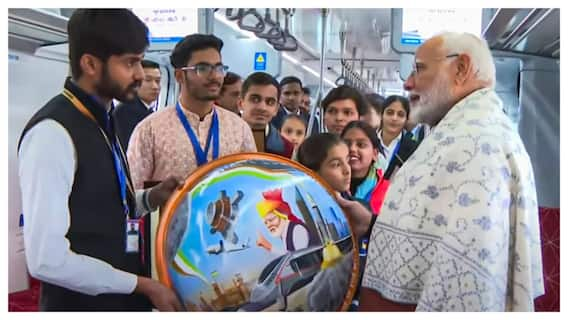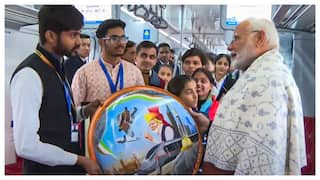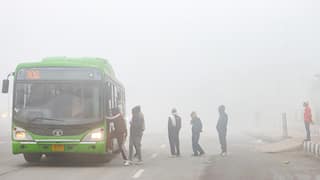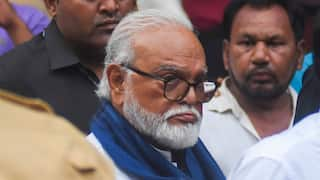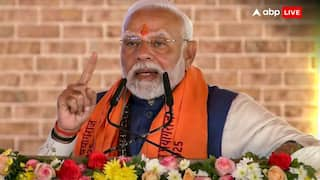High-Income Country By 2047: What Are The Challenges And How India Plans To Realise Its Goal
Before becoming a high-income economy, India will have to reach middle- and upper middle-income status first. Competitiveness diagnostics have listed a few challenges on the road to 2047.

India has overtaken the United Kingdom to become the fifth-largest economy in the world, according to the International Monetary Fund’s projections. Only the US, China, Japan and Germany are ahead of India currently. The projections were shared days after the Economic Advisory Council to the Prime Minister (EAC-PM) released the Competitiveness Roadmap for India@100, which said India could become a high-income country by 2047 India.
However, though India is now the world's fifth largest economy, with a GDP of $2.7 trillion, it is currently classified as a lower middle-income country. To become a high-income economy, India will need to focus on sector-specific and region-specific policies, and manage a sustained growth rate of 7-7.5 per cent for the next 25 years, EAC-PM Chairman Bibek Debroy said while releasing the document late last month.
"Even if you have relatively conservative real rates of growth of 7-7.5 per cent, we will get to a per capita income of about USD 10,000. And you will get to a total size of the economy of a little less than USD 20 trillion in 2047," he said.
Before becoming a high-income economy, however, India will have to reach middle- and upper middle-income status first.
What High-Income Status Would Mean
A middle-income status would make India a $7 trillion economy, which is 2.5 times the size of today. It would mean 80% high prosperity — on PPP terms — compared to where India stands today. The India@100 report says a high-income status would mean becoming a $60 trillion economy, which would be 20 times the size of today, and more than 2.5 times the current size of the US economy.
The Challenges Ahead
India has over the last 30 years achieved an average annual per capita growth rate above 3.5%, and during this period its five-year moving average annual prosperity growth rate never dropped below 2%, the India@100 report notes. The ambition to reach middle-income and eventually high-income status is still a high hill to climb.
The report says India needs to increase its labour productivity and labour mobilisation to become a middle income country. While the labour productivity rate is on track and will reach the level of other middle income countries by 2045, there has been a gap when it comes to mobilisation of labour. The report said a significant change is needed to achieve the outcome required to earn middle income. It will then require a dramatic increase in labour productivity to achieve further gains toward a high income status.
For the record, the labour productivity of high-income countries is about 3 times that of middle-income countries.
There are several challenges ahead. The competitiveness diagnostics have listed three particular ones — shared prosperity challenge, the jobs challenge, and the policy implementation challenge.
Also Read: '4S' Principles That Redefine India's Approach To Achieve Prosperity By 2047
Shared Prosperity Challenge: Inequality is one of the major issues that India needs to tackle to ensure an overall growth of the country. Acknowledging this as the first challenge, the India@100 report says all of India does not benefit from the gains achieved in aggregate, and a lot needs to be done on this front.
While India’s GDP has steadily grown, and the country has seen significant average prosperity growth over the years, all sections of society have not got a sufficient share of these gains.
“Inequality has been rising dramatically. The poor have seen their living conditions improve because of more effective policies to help those in need. But many of them are only slightly above the poverty line, and their gains disappeared during the pandemic. Most income gains were registered at the very top of the income distribution,” the report says.
While other countries also show these trends, India “stands out for the extent of this imbalance”.
The report notes that the government’s “Ease of Living” policy is a step towards shared prosperity, but data shows India is lagging behind on this front both on overall social progress and “specifically on areas related to environmental quality, health care, and inclusion”.
Large parts of India still remain unconnected to the modern economy, despite better basic services and improvement in infrastructure connectivity.
Jobs challenge: Lack of enough good jobs is the second key challenge listed by the competitiveness diagnostics. And this, the India@100 report says, is connected to shared prosperity because “job trajectories that allow growth in value creation over time are the key to sustained prosperity gains”.
With a steady rise in the number of working age population, India has a demographic opportunity that needs to be unlocked. “But job creation has essentially been flat over recent years, especially in those manufacturing and advanced service sectors that were supposed to drive growth,” the report notes.
Labour mobilisation is an area that needs focus because it has seen a dramatic decline over the last four decades. While much of the recent drop occurred among working-age men, a particular challenge, according to the report, is the low participation rate of the female labour force. Other countries have seen rising female participation as a key driver of growth.
Another big challenge is the fact that many existing jobs are informal and irregular in nature, and they give lower incentives to make investments into assets that would drive higher productivity, the report says.
Policy implementation challenge: The Indian economy opened to market forces, both internally and externally, in the early 1990s, creating many new opportunities. The focus has now broadened with infrastructure and skill upgrade, opening of domestic markets, ‘Ease of Doing Business’, and making the social policies more efficient, with the actions targeted at accelerating the economic performance of the country.
The outcomes, however, have fallen short. India has by and large failed to achieve the expected impact from its policies, and this is the third key challenge noted by the India@100 report.
Compared to the initial market opening reforms of the 1990s, the report says, the reforms needed and started over the last few years are “more demanding” in terms of their implementation. “They require action and often coordination across many different levels of government, as well as across functionally specialized ministries and agencies. Their impact often depends not simply on executing given policies uniformly across the country but on adapting them to the specific circumstances in each state, district, or city. This puts high demands on the capabilities of a much larger group of individuals across the public sector.”
India@100 Strategy Suggests The Way Ahead
According to the India@100 report, the future performance of India will depend on how well it addresses today’s challenges, and also on how well it responds to the changes it will face on this front in the coming years.
“India needs to ensure that its policy choices are robust in view of these changes ahead, and are not based on outdated ideas of what it will take to achieve economic development,” it says.
A transparent articulation of the economic development goals is what India should base its strategy on to make it effective. "These goals should outline an ambition that is bold, energizing, and reflective of the aspirations of the country," the report says.
An integration of all social and economic development agendas should be the first pillar of the new development approach, it says, adding that the India@100 strategy views these agendas as fundamentally connected. "Economic growth that does not achieve social development fractures society and ultimately erodes the very foundations of prosperity. Social progress that is not conducive to economic development becomes economically unsustainable."
'Structural Transformation 2.0' has been stated as the second pillar of the new development approach as the India@100 strategy says the old model of industrialisation has limited economic power. 'Structural Transformation 2.0' will see how individual sectors will contribute to job creation and growth, aligned with the global economy.
While the cometitiveness roadmap has written down the guiding principles to steer India towards 2047, the India@100 strategy "translates guiding principles into prioritised policy action". The first set of policies, according to it, focuses on enabling competitive jobs that will let earn wages in the marketplace, support the employees' livelihood, and provide opportunities to develope capabilities and productivity.
Enabling the growth of competitive firms is what the second set of policies is focused on. If India cannot enable more productive firms to emerge and grow, no sustainable job creation will be possible after all, the report notes.
There is a third set of policies that is focused on creating a "competitive government" that is able to "design and implement the policies needed for competitive firms to create competitive jobs".
Trending News
Top Headlines








